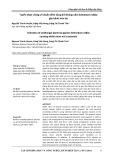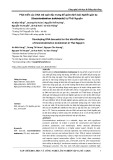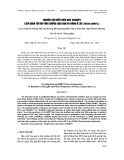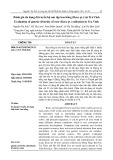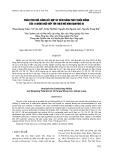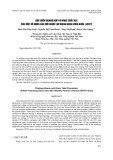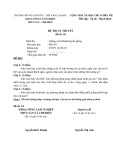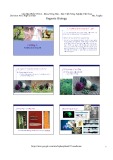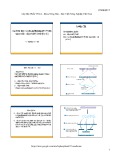
74 Nong Lam University, Ho Chi Minh City
The Journal of Agriculture and Development 23(Special issue 1) www.jad.hcmuaf.edu.vn
Presence of metal-resistance and antibiotic-resistance genes in Salmonella spp. isolated from
broiler chicken farms in Vinh Long province, Vietnam
Luan M. Huynh1,2, Thuan K. Nguyen2*, Duy D. Nguyen2, & Khai T. L. Ly2
1Faculty of Applied Biological Sciences, Vinh Long University of Technology Education, Vinh Long, Vietnam
2Faculty of Veterinary Medicine, College of Agriculture, Can Tho University, Can Tho, Vietnam
ARTICLE INFO ABSTRACT
Research Paper
Received: August 17, 2024
Revised: October 01, 2024
Accepted: October 04, 2024
Keywords
Antibiotic resistance
Chicken farm
Metal resistance
Salmonella
Vinh Long
*Corresponding author
Nguyen Khanh Thuan
Email:
nkthuan@ctu.edu.vn
Salmonella can carry multiple antibiotic-resistant and metal-
resistant genes and transmit these genes among strains worldwide.
This study examined seventy-five Salmonella isolates from
small-scale chicken farms (chicken feces, bedding, feed, wild
animals) in Vinh Long province for the presence and relation of
antibiotic and metal-resistance genes in these strains. The single
PCR method was applied to detect seven antibiotic-resistance
genes (blaampC, blaTEM, dfrA1, tetA, strA, sul2, mcr1) and
four metal-resistance genes (pcoR, czcD, cnrA, silE). The results
indicated that those Salmonella isolates harbored several patterns
of antibiotic-resistance genes. Genes blaampC and tetA were the
most prevalent (48.00%), while genes mcr1 and dfrA were the most
minor (1.33%). Of those Salmonella isolates, 92.00% harbored
one to five antibiotic-resistance genes, and the blaampC + strA
pattern was frequently obtained (12.00%). Moreover, 30.67%
of Salmonella isolates showed multidrug resistance to three or
four antibiotic categories. Among metal-resistance genes, gene
pcoR encoding for copper resistance was the most predominant
(53.33%), and gene cnrA encoding for cobalt-nickel resistance
was the lowest (5.33%). There were diverse patterns of metal-
resistance genes, and one Salmonella isolate carried four examined
genes (1.33%). Furthermore, these Salmonella isolates had several
combined patterns of metal-resistance and antibiotic-resistance
genes. Among them, pcoR, czcD, and silE genes had a significant
coefficient relation to the examined antibiotic-resistance genes. It
indicated the correlation between metal resistance and antibiotic
resistance genes and revealed the potential risk of increasing
antibiotic resistance in Salmonella isolates in chicken farms in
Vinh Long province.
Cited as: Huynh, L. M., Nguyen, T. K., Nguyen, D. D., & Ly, K. T. L. (2024). Presence of metal-
resistance and antibiotic-resistance genes in Salmonella spp. isolated from broiler chicken farms in
Vinh Long province, Vietnam. The Journal of Agriculture and Development 23 (Special issue 1), 74-87.

Nong Lam University, Ho Chi Minh City 75
The Journal of Agriculture and Development 23(Special issue 1) www.jad.hcmuaf.edu.vn
in insufficient focus on pathogenic bacteria’s
resistance to these metals. The occurrence of
heavy metal resistance genes in Salmonella
showed the relationship between these genes and
antibiotic-resistance genes (Yang et al., 2020). It
has been demonstrated that the co-selection of
antibiotic-resistance genes resulting from the
presence of heavy metals significantly contributed
to the observed rise in antibiotic-resistance genes
abundance (Stepanauskas et al., 2006; Mazhar
et al., 2021) and acted as a selective factor in
their proliferation (Allen et al., 2010). Yang et
al. (2020) reported that the presence of metal-
resistance genes (zntA, arsB, merA, pcoR, pcoA,
pcoC, and chrA) was found to be significantly
associated with one or more antibiotic-resistance
genes (sul1, sul2, sul3, tetA, tetB, tetC, blaTEM,
blaSHV, and blaCTX). The interaction of these
genes has increased the antibiotic resistance
in bacteria, including Salmonella, in chicken
farms. Moreover, disinfectants are essential
in controlling the growth and transmission of
pathogens. Nonetheless, the selective pressure
imposed by disinfectants and heavy metals on
microbial pathogens is increasingly recognized as
a significant factor that drives the selection and
dissemination of antimicrobial resistance within
the food chain of humans and animals (Capita &
Alonso-Calleja, 2013; Tezel & Pavlostathis, 2015).
In Vinh Long province, chickens were raised
frequently; however, most farms were small-scale.
The hygiene in these small-scale farms was not
managed well; the pathogens could survive and
spread via chickens or the environment (Alali et
al., 2010; Nguyen et al., 2021). The prevalence and
antibiotic resistance of Salmonella was recorded
in several previous reports. However, few
studies have been published on the prevalence of
antibiotic-resistant genes. In contrast, no studies
have been published on metal-resistance genes in
1. Introduction
Salmonella is one of the major foodborne
pathogens that can pose a significant threat to
public health, mainly through the consumption
of contaminated poultry products (Chuanchuen
et al., 2008; Dantas et al., 2020). Salmonella also
causes infection in poultry, and contamination
in the poultry environment facilitates the
transmission of Salmonella through both vertical
and horizontal pathways (Singh et al., 2010). In
a previous report, Salmonella was isolated from
chicken feces (7.67%), pest animals (5.98%), such
as geckos, ants, cockroaches, and environmental
samples (4.33%) in the chicken farms in the
Mekong Delta, Vietnam (Nguyen et al., 2021).
It indicated that Salmonella is a potential risk-
causing disease for chickens and transmission in
the husbandry environment.
On the other hand, the emergence of
antibiotic-resistant Salmonella strains in food
animals, including chickens, is a growing concern
(Nair et al., 2018). Most Salmonella isolates
have developed resistance to multiple drugs
because of farmers’ indiscriminate and repeated
misuse of these antibiotics. The extensive use
of antimicrobials in food animal production
has been a critical driver of this trend, as it can
promote the development and dissemination of
resistant strains (Kulwichit et al., 2007). Zhu et
al. (2017) reported that Salmonella isolated from
broiler chickens in slaughterhouses in China
exhibited multidrug resistance and harbored
several antibiotic-resistance genes, such as
blaTEM, blaCTX-M, tetA, sul2, floR, aadA1,
drfA1, etc. Thus, screening for antimicrobial
resistance in Salmonella is crucial for managing
and treating Salmonella infections in poultry.
The extensive application of heavy metals as
feed additives in livestock production has resulted

76 Nong Lam University, Ho Chi Minh City
The Journal of Agriculture and Development 23(Special issue 1) www.jad.hcmuaf.edu.vn
& Dablool, 2017) and stored at -20oC for use
in this experiment. The single PCR assay was
applied to detect seven antibiotic-resistance
genes, including β-lactam (blaampC, blaTEM),
aminoglycoside (strA), tetracycline (tetA),
polypeptide (colistin-mcr1), sulfonamide (sul2),
and diaminopyrimidine (dfrA1) (Table 1). The
PCR conditions followed the description of
references in Table 1, respectively. These genes
were often detected in Salmonella and E. coli
isolated from chickens in previous studies in the
Mekong Delta (Nguyen et al., 2015; Nguyen et
al., 2021) and represented antibiotic types used
frequently in our surveys in the small-scale
chicken farms.
The MyTaq Mix 2X (BIO25042, Bioline,
Meridian Bioscience, USA) was in the PCR
reaction as a master mix. One reaction consists of
a total of 25.0 µL, including Mastermix 2X (12.5
µL), forward primer (0.5 µL), reverse primer
(0.5 µL), distillation water (9.5 µL), and DNA
template (2.0 µL). Thermal cycle was modified
as follows: 94oC - 5 min; 30 cycles: 94oC - 1
min, 58oC - 45 sec, 72oC - 1 min; 72oC - 10 min.
The Salmonella isolates harbored those genes,
previously isolated from domestic animals in the
Mekong Delta, were used as a control. The PCR
products were electrophoresed in 1.5% agarose
gel at 50V for 60 min. Then, the gels were dyed in
ethidium bromide (0.001 mg/L) before capturing
the image under UV.
2.3. Identification of metal-resistance genes in
Salmonella isolates
This study also used the DNA of seventy-
five Salmonella isolates to detect the presence of
metal-resistance genes. The single PCR (25.0 µL/
reaction) and electrophoresis procedures were
conducted like those used to detect antibiotic-
resistance genes.
Salmonella isolated from chickens or husbandry
environments in the Mekong Delta, including
Vinh Long province. Therefore, this study aims to
clarify the prevalence of antibiotic-resistance and
metal-resistance genes in Salmonella originating
from chickens and the surrounding environment.
This research could provide valuable insights into
the potential risk of those antibiotic-resistant
Salmonella strains and inform strategies for
mitigating poultry health risks in those farms.
2. Materials and Methods
2.1. The origin of Salmonella isolates
This study used 75 Salmonella isolates,
which were isolated from broiler chicken feces
(n = 15), husbandry environment samples:
bedding samples (n = 6) and feed (n = 4), pests:
geckos (n = 38), rats (n = 8), and ants (n = 4)
in four different small-scale farms in Tam Binh
and Mang Thit districts, Vinh Long province.
These positive Salmonella strains were detected
from 1,265 samples (chickens’ feces, pests, and
husbandry environment) from February 2022 to
December 2022. The isolation and identification
of Salmonella isolates were performed according
to the instructions of Barrow & Feltham (2003).
These Salmonella isolates were kept in Tryptic
Soy Broth (TSB, Merck, Germany) supplied with
15% glycerol (Merck, Germany) at -80oC freezer
in the Veterinary Food Hygiene Laboratory,
Faculty of Veterinary Medicine, College of
Agriculture, Can Tho University, Vietnam. One
positive Salmonella isolate, representative of one
positive sample, was selected for use in this study.
2.2. Identification of antibiotic-resistance
genes in Salmonella isolates
The DNA of 75 Salmonella isolates was
extracted using the heat-shock method (Ahmed

Nong Lam University, Ho Chi Minh City 77
The Journal of Agriculture and Development 23(Special issue 1) www.jad.hcmuaf.edu.vn
descriptions of references in Table 1, respectively.
The Salmonella isolates harboring these metal-
resistance genes, previously isolated from
domestic animals (pigs, chickens) in our pilot
studies in the Mekong Delta, were used as a
control. The PCR products were electrophoresed
in 1.5% agarose gel at 50V for 60 min. Then,
the gels were dyed in ethidium bromide (0,001
mg/L) before capturing the image under UV.
Four metal-resistance genes were examined
for genes encoding resistance to copper (pcoR),
cobalt-zinc-cadmium (czcD), cobalt-nickel
(cnrA), and silver (silE) (Table 1). These metal-
resistance genes were reported in several previous
studies in Salmonella and E. coli, and these heavy
metals were commonly used in disinfectant
products (Woods et al., 2009; Yang et al., 2020;
Mustafa et al., 2021).
The PCR conditions and primer sequences
(pcoR, czcD, cnrA, and silE) followed the
Table 1. The nucleotide sequence of antibiotic-resistance and metal-resistance primers used in
this study
Genes Sequence 5’-3’ Size (bp) References
Antibiotic-resistance genes
blaampC AATGGGTTTTCTACGGTCTG
GGGCAGCAAATGTGGAGCAA
191 Caroff et al. (1999)
blaTEM ATTCTTGAAGACGAAAGGGC
ACGCTCAGTGGAACGAAAAC
1.150 Jouini et al. (2007)
strA CCTGGTGATAACGGCAATTC
CCAATCGCAGATAGAAGGC
546 Carattoli et al. (2002)
tetA GGTTCACTCGAACGACGTCA
CTGTCCGACAAGTTGCATGA
577 Randall et al. (2004)
mcr-1 CGGTCAGTCCGTTTGTTC
CTTGGTCGGTCTGTAGGG
309 Elnahriry et al. (2016)
sul2 CGGCATCGTCAACATAACC
GTGTGCGGATGAAGTCAG
722 Sáenz et al. (2010)
dfrA1 GGAGTGCCAAAGGTGAACAGC
GAGGCGAAGTCTTGGGTAAAAAC
367 Peirano et al. (2006)
Metal-resistance genes
pcoR CAGGTCGTTACCTGCAGCAG
CTCTGATCTCCAGGACATATC
636 Yang et al. (2020)
czcD CAGGTCACTGACACGACCAT
CATGCTGATGAGATTGATGATC
398 Anton et al. (2004)
cnrA CCTACGATCTCGCAGGTGAC
GCAGTGTCACGGAAACAACC
422 Mustafa et al. (2021)
silE AGGGGAAACGGTCTGACTTC
ATATCCATGAGCGGGTCAAC
432 Woods et al. (2009)

78 Nong Lam University, Ho Chi Minh City
The Journal of Agriculture and Development 23(Special issue 1) www.jad.hcmuaf.edu.vn
The results (Table 2, Figure 1) indicated that
blaampC and tetA genes were detected at the
highest rate (48.00%), followed by strA (42.67%),
and the most minor ones were genes dfrA1 and
mcr-1 (1.33%). Those genes encode resistance
to favored antibiotic groups (β-lactam, cycline,
and aminoglycoside) frequently used to treat
salmonellosis in poultry and used in small-scale
farms in Vinh Long province, according to our
previous studies and other reports (Nguyen et
al., 2017; Nguyen et al., 2021). This indicated
that Salmonella isolated from small-scale farms
could resist antibiotics currently used, causing
challenges in choosing suitable antibiotics for
treating diseases there. Yildirim et al. (2011)
stated that the variations in resistance were also
linked to the specific serovar of Salmonella, the
type of poultry (broilers or layers), individual
farms, and the specific antimicrobial agents used.
2.4. Statistical analysis
The statistical analysis was used to clarify
the difference in the presence of antibiotic-
resistant and metal-resistant genes among those
Salmonella isolates. The Chi-square method
was used to define the significant difference in
the presence of antibiotic-resistant and metal-
resistant genes at a confidence level of 95%.
Spearman’s correlation coefficient was used
to determine the relation between antibiotic-
resistant and metal-resistant genes. These
analyses were performed in Minitab software
version 17.0 (Minitab LLC, USA).
3. Results and Discussions
3.1. The presence of antibiotic-resistance genes
in Salmonella isolates
Figure 1. The electrophoresis image of PCR products in detecting antibiotic-resistance genes in
Salmonella spp. isolates. M: ladder (100 bp), N: negative control (Distilled water), 1: blaampC
(191 bp), 2: dfrA (367 bp), 3: tetA (577 bp), 4: mcr-1 (309 bp), 5: strA (546 bp), 6: sul2 (722 bp), 7:
blaTEM (1.150bp).


